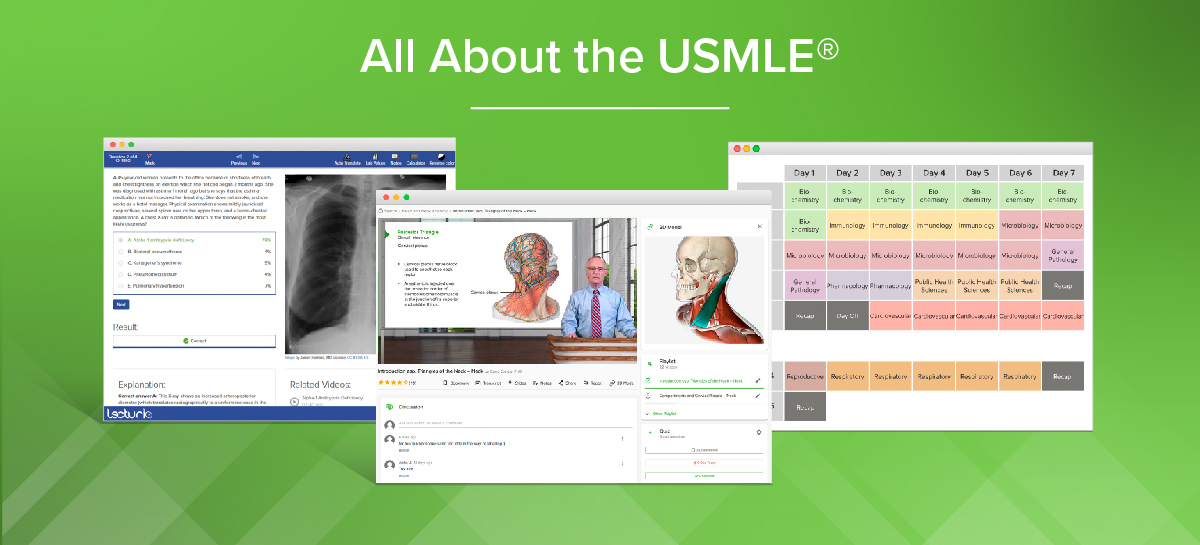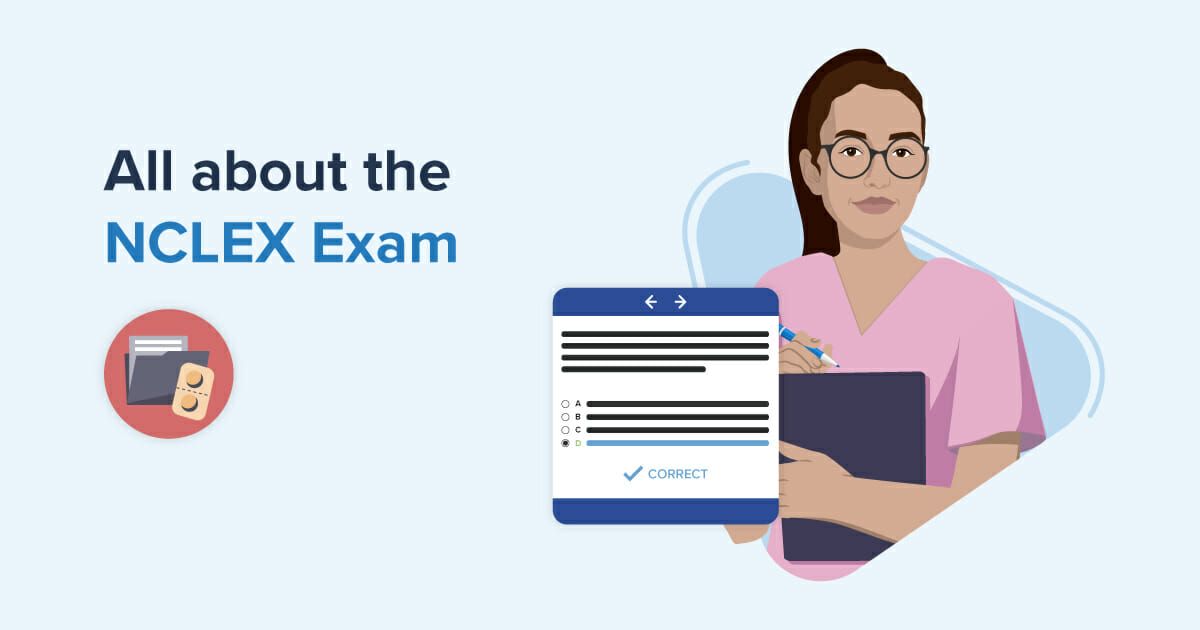The NCLEX and USMLE are key exams to license healthcare professionals, but they are designed for distinct roles. While meant for two separate professions, they are equally high-stakes for their respective test-takers. They are often compared because they feature case-based questions to test clinical judgment and decision-making.
While nursing and medical students often take an interest in each other’s licensing process, these exams are also compared for people considering a transition in their professions. Some nurses may want to enter medicine or some doctors may shift to nursing. Many of them are international medical graduates (IMGs), exploring their options for exams. Regardless of your background or goals, or where you are in this journey, this article may have the answers you’re looking for.
In this article, we will define the purpose of each exam, compare their exam formats, briefly discuss which one is harder, and share some tips and strategies to successfully navigate both exams!
NCLEX vs. USMLE: What’s the Purpose of Each Exam?
The NCLEX-RN (National Council Licensure Examination) is a standardized test to assess if nurses are ready to safely practice as Registered Nurses (RNs) in the U.S. There is another version called the NCLEX-PN which is for becoming a Practicing/Vocational Nurse (LPNs/LVNs). Apart from having to memorize facts, the focus of the test is on being able to apply that knowledge to real-world nursing scenarios.
The USMLE (United States Medical Licensing Examination) is a multi-step exam that evaluates the knowledge of medical students and tests their readiness for clinical training. Split into 3 “Steps”, these exams test each stage the test taker has finished, which will be discussed in more detail later. The purpose of each step is to evaluate if each test-taker is ready for their next milestone. Step 1 evaluates your understanding of fundamental sciences. Step 2 focuses on your medical knowledge and ability to integrate that knowledge to clinical practice. Step 3 determines if you’re ready to apply everything you’ve learned to actual practice, unsupervised.
Exam Format Comparison
Taking an exam without understanding it is like fighting with only a sword but having no idea on how to wield it. When you enter the examination room, you should already have a strategy in mind. To do this, you need to understand the exam’s length, question types, scoring, passing rates, and structure.
Number of questions and length
In April 2023, a new NCLEX format was implemented, which includes Next Generation NCLEX (NGN). The NGN is a variable-length exam with a minimum of 85 questions and a maximum of 150. Since the length can vary, you have up to 5 hours to complete the exam.
The USMLE – First Step follows a fixed set of 280 multiple-choice questions. The first step is divided into seven 60-minute blocks, to be completed over 8 hours. The second step adds an eighth block, also for 60 minutes, which takes 9 hours to complete. The questions do not exceed 318 items. Lastly, Step 3 takes place over the course of 2 days. The first day has 232 items, divided into 6 blocks with 60 minutes each to complete. Then, the second day has 180 questions, divided into 6 blocks with 45 minutes for each block. This is followed by 13 case simulations which take 10-20 minutes to complete in real time.
Question format
The NCLEX uses computerized adaptive testing. That means the program adjusts the questions given to you based on your responses. Why does it do that? Because “easy” questions don’t accurately measure the extent of your ability, and “hard” questions make the candidate rely on guesswork. The question format can vary between (but are not limited to) multiple-choice, drag-and-drop, drop-down, and highlighting answers. There are 15 question types in the new NCLEX system.
The USMLE primarily uses multiple choice questions, in case-based format through clinical vignettes. The last step includes multiple-choice questions but it also uses computer-based case simulations.
Scoring and Passing Rate
With the NCLEX, it’s either you pass or fail the exam. The scoring is more complicated than simply giving you a score for every correct answer you get. Some questions are scored in the traditional way where a correct answer gets you +1 point while an incorrect one gets you no point. However, some questions are right-minus-wrong. This means you get +1 score for a correct answer, but -1 for a wrong one. The passing rate for the past 5 years has varied between 63.39% to 73.26% for all candidates, whether US or non-US.
The USMLE scoring varies between each step. The first step is either a pass or a fail. Then, the second has a minimum passing score of 215. Lastly, the third step has a passing score of 200. The passing rate for US/Canadian candidates the past 5 years ranged from 88% to as high as 98%. Meanwhile, non-US/Canadian candidates have ranged from 68% to 89%.
| SUMMARY TABLE | NCLEX | USMLE |
| Number of items | Maximum 150 | Step 1: 280 Step 2: 318 Step 3: 232 |
| Time Limit | 5 hours | Step 1: 8 hours Step 2: 9 hours Step 3: ~10 hours |
| Question Format | Multiple response (including charts, audio, and graphics), “Hot spot”, Fill-in-the-blank, and Drag-and-drop/ordered response questions | Multiple-choice and computer-based simulations |
| Scoring | Pass or Fail | Based on a three-digit score scale Step 1: Pass or Fail Step 2: Minimum score of 215 Step 3: Minimum score of 200 |
| Passing rate (For all candidates, for the past 5 years) | 63.39% to 73.26% | 68 to 98% |
Which Exam is Harder? (Key Differences & Challenges)
It is often debated as to which one is harder: the NCLEX or the USMLE. Apart from their vastly differing testing styles, they both require a unique set of skills to pass.
NCLEX Challenges
The NCLEX, especially with the new system in place, tests critical thinking and decision-making, not just memorizing facts from school lectures or a book. It’s about applying your knowledge to real-world scenarios that may occur while working as a nurse. Even as you answer correctly, the adaptive nature of the test can make it feel progressively harder. This can undermine your confidence and affect your time since you only have 5 hours to answer the exam. So a certain amount of flexibility and versatility is required.
USMLE Challenges
The USMLE has multiple steps that take hours to complete and even more grueling hours of preparation. The sheer volume of content require for each step can be overwhelming. Endurance, time management, and clinical practice are key to passing these exams. It is extremely content-heavy where memorization can take you far, but using what you’ve learned to actual patient care takes you further. What matters are your problem-solving skills because a lot of questions are case-based and you need to give the best possible answer, not just the correct one.
Difficulty Verdict
Where the USMLE requires a deeper understanding of medical knowledge, the NCLEX demands stronger application skills. Both require outstanding clinical judgment to pass, and a lot of grit to make it through everything. At this point, it’s hard to say which exam is easier to sit through. So let’s go through some strategies that you could use!
Study Strategies for Each Exam
NCLEX Strategies
#1: Understand the item formats
The structure of the NGN is unique, to say the least. There are multiple different formats that you can encounter, and it can be jarring each time it changes. So you have to read through how each question type works before the exam starts so you don’t waste time trying to understand the directions.
#2: Focus on clinical judgment
While the exam calls for a lot of medical facts, the focus of the test is to determine how effectively you approach cases. It checks if you can properly assess the patient, analyze their case, come up with appropriate plans, implement the plans, and evaluate the patient outcomes.
#3: Master the exam through practice
Once you’ve familiarized yourself with the structure of the exam, it’s time to test your skills. The best approach is through practice questions. These can be accessed on educational resources like Lecturio where you can master the NCLEX’s Next-Gen unique question types with their expert guide.
USMLE Strategies
#1: Take it one step at a time
No pun intended. Focus on finishing Step 1 before thinking about what comes next. This is the backbone of everything you do in medicine and your guide to proper patient management, leading all the way to Step 3.
#2: Maintain consistency in studying
Having consistent and healthy study behaviors throughout your medical career will save you a lot of time and stress. This means no cramming and no erratic studying in short bursts. Don’t forget to take a step back to take care of yourself. Take your time– this is a marathon, not a sprint. Instead, make use of active recall and spaced repetition.
#3: Use question banks
The USMLE requires a multi-step approach for each question. First, you have to understand what is being asked. Next, recall relevant medical knowledge related to the case. Then, you have to apply that knowledge using conceptual mastery of each medical science. This makes the USMLE an incredibly mentally-challenging exam. So the best approach is to practice using question banks. These are available on Lecturio’s Qbank for USMLE Step 1, along with learning paths to best prepare you for even the most difficult USMLE questions.
Final Verdict: Which Exam is Tougher?
The USMLE requires a lot of memorization and recall of complicated medical concepts. Because each step follows a particular medical career milestone, the process takes time. Each step requires a deeper understanding of knowledge each time, making the journey extremely tiring.
The NCLEX requires the application of nursing knowledge to patient care. The exam is not only designed to assess you. It challenges you the further you go and the better you answer. It tests your mental strength and clinical judgement in the span of 5 hours, which for many, can be daunting.
The verdict is that both exams ask for a lot and a specific set of skills that aren’t for everyone. If you have a hard time with memorization and recall, as well as spending years of your practice still intensively studying, then you will find the USMLE more difficult. If you have trouble with applying your school knowledge to real cases of patients and adjusting to an adaptive exam with varying structures and item difficulties, you may find the NCLEX harder.
Conclusion
Both exams are challenging in their own right. There is no ‘easier’ exam, only an exam that matches your skills better. Choosing between the USMLE and the NCLEX is like choosing between running a marathon and an obstacle course. A marathon relies on endurance, but an obstacle course relies on your ability to adapt.
Apart from the exam itself, you have to consider your long-term plans and think which profession would suit you best. Do you have what it takes to work as a doctor? Is nursing where your passion lies? Both jobs lead different lifestyles where one may fit your life goals more than the other.
Also, consider your strengths and weaknesses. Are you good at memorizing? Does quick decision-making stress you out? Is deductive reasoning your strong suit? Do you enjoy being challenged in one big exam rather than a series of multiple exams? If you’re particularly open-minded, you can also take the NCLEX then the USMLE while practising as a registered nurse. The possibilities are entirely up to you.
It can feel overwhelming and like you’re not prepared to take either exam, but that’s okay. Lecturio has preparation guides for the USMLE where you can master the exam, one subject at a time. They also have a guide for the NCLEX where you can practice answering questions for the actual exam. Once you’ve gotten an idea of what each exam lies in store, it’ll be easier to make a decision– and Lecturio is there to guide you the whole way.





